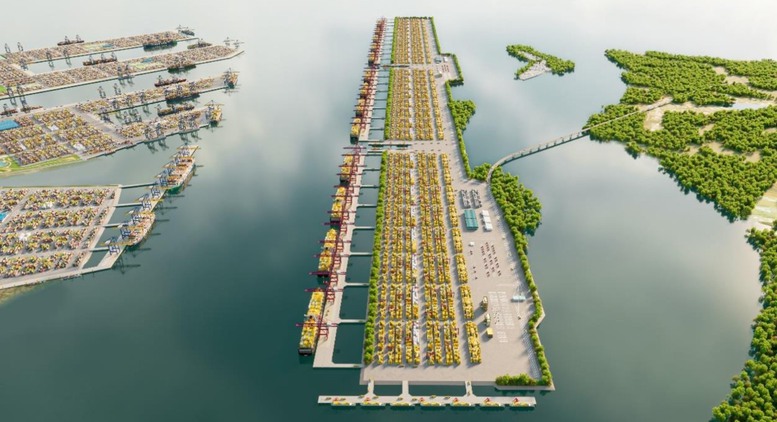 |
| Perspective of Can Gio International Transit Port Area. |
The Minister of Construction has just signed Decision No. 407/QD-BXD approving the Detailed Plan for the development of land and seaport areas in Ho Chi Minh City for the 2021-2030 period, with a vision to 2050.
Ho Chi Minh City seaport includes the following wharf areas: Cat Lai - Phu Huu, Saigon River, Hiep Phuoc, Nha Be, Long Binh, Can Gio international transit port area, potential ports in Can Gio district, buoy wharfs, anchorage areas, storm shelters.
According to Decision No. 407, by 2030, the Ho Chi Minh City seaport system will have a cargo throughput of 228 million to 253 million tons (of which container cargo will be from 11.41 million TEU to 12.8 million TEU, excluding international transit container cargo); passengers will be from 170,600 to 184,400.
Also in the period up to 2030, the Ho Chi Minh City seaport system will have a total of 41 to 44 ports including 89 to 94 wharves with a total length of 16,588.2 m to 18,588.2 m (not including other ports).
Regarding the vision to 2050, the planning determines that the volume of goods through the Ho Chi Minh City seaport system will have an average growth rate of about 3.5%/year to 3.8%/year; passengers will have an average growth rate of about 0.9%/year to 1.0%/year.
Regarding infrastructure, the plan determines to continue investing in the Can Gio international transit port area in Ho Chi Minh City to form a large-scale international transit port cluster with the scale of the Asian and international regions together with the ports in Cai Mep - Thi Vai area; complete the relocation of ports on the Saigon River in accordance with the development of urban space in Ho Chi Minh City.
In Decision No. 407, the Ministry of Construction has detailed planning for Can Gio International Transit Port Area.
Specifically, in the period up to 2030, Can Gio International Transit Port Area will have a cargo throughput of 22.8 million tons to 57.6 million tons (equivalent to 2.4 million TEU to 4.8 million TEU).
Can Gio international transit port area has a total of 2 to 4 ports including 2 to 4 wharves with a total length of 1,016 m to 2,016 m.
In particular, Can Gio international transit port has from 2 to 4 container wharves with a total length of 1,016 m to 2,016 m, receiving ships with a capacity of up to 250,000 tons (24,000 TEU) or larger when qualified, meeting the need to pass through goods from 22.8 million tons to 57.6 million tons (equivalent to 2.4 million TEU to 4.8 million TEU).
Vision to 2050, Can Gio International Transit Port Area is expected to develop about 13 ports to meet the demand for international container transit and cargo growth.
It is estimated that the total investment capital demand for the seaport system by 2030 is about 77,452 billion VND, including investment capital for public maritime infrastructure of about 2,952 billion VND and investment capital demand for ports of about 74,500 billion VND (including only ports providing cargo handling services).
Projects in the Ho Chi Minh City seaport system that are prioritized include: investing in channels for ships with a capacity of up to 250,000 tons to enter Can Gio international transit port in sync with the scale of the ports; investing in public infrastructure serving maritime safety such as anchorage areas, storm shelters, facilities serving specialized state management tasks; investing in tourist ports, international passenger ports and marinas associated with dynamic tourism development areas...
To implement the planning, the Ministry of Construction will coordinate with ministries, branches and localities to encourage common service ports in economic zones, industrial zones and industrial clusters to improve the efficiency of port investment, land fund and water surface; new investment ports in Can Gio international transit port area commit that the volume of Vietnam's import and export goods loaded and unloaded at the port does not exceed 20% to 25% of the total demand for goods through.
At the same time, continue to improve the mechanism and conditions to mobilize diverse domestic and foreign resources to participate in investing in developing seaport infrastructure according to the planning and institutionalize solutions on decentralization and delegation of authority to mobilize resources; exploit resources from land funds, water surfaces, and revenue from leasing and exploiting port infrastructure invested from the budget.
In addition, the Ministry of Construction will encourage and facilitate organizations and enterprises of all economic sectors to participate in investing in the development and exploitation of seaports; continue to promote the socialization of investment in the development of seaport infrastructure.
Strengthen the role of enterprises in sharing the responsibility for investment and maintenance of public infrastructure at seaports as part of their seaport exploitation investment projects.
Source: https://baodautu.vn/can-toi-77452-ty-dong-de-dau-tu-he-thong-cang-bien-tphcm-den-nam-2030-d266230.html



![[Photo] General Secretary To Lam receives Chief of the Central Office of the Lao People's Revolutionary Party](https://vphoto.vietnam.vn/thumb/1200x675/vietnam/resource/IMAGE/2025/5/30/140435f4b39d4599a3d17975dfb444c5)
![[Photo] National Conference "100 years of Vietnamese Revolutionary Press accompanying the glorious cause of the Party and the nation"](https://vphoto.vietnam.vn/thumb/1200x675/vietnam/resource/IMAGE/2025/5/30/1cf6cd5c8a934ebfa347028dcb08358c)

![[Photo] Journalists moved to tears at the Memorial Service for the soldiers who died in Gac Ma](https://vphoto.vietnam.vn/thumb/1200x675/vietnam/resource/IMAGE/2025/5/30/9454613a55c54c16bf8c0efa51883456)
![[Photo] A delegation of 100 journalists from the Vietnam Journalists Association visits the soldiers and people of Truong Sa island district.](https://vphoto.vietnam.vn/thumb/1200x675/vietnam/resource/IMAGE/2025/5/30/0984a986227d4e988177f560d2e1563e)






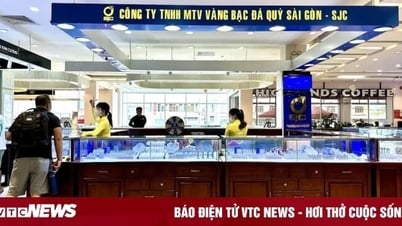








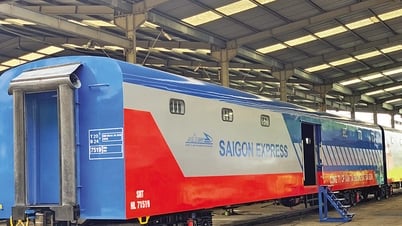



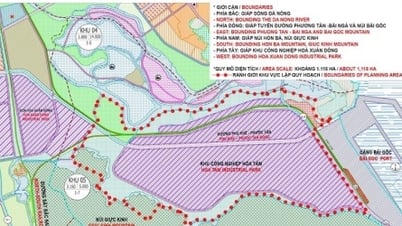














































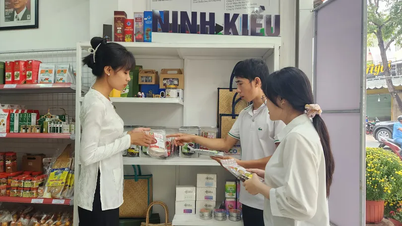



















Comment (0)